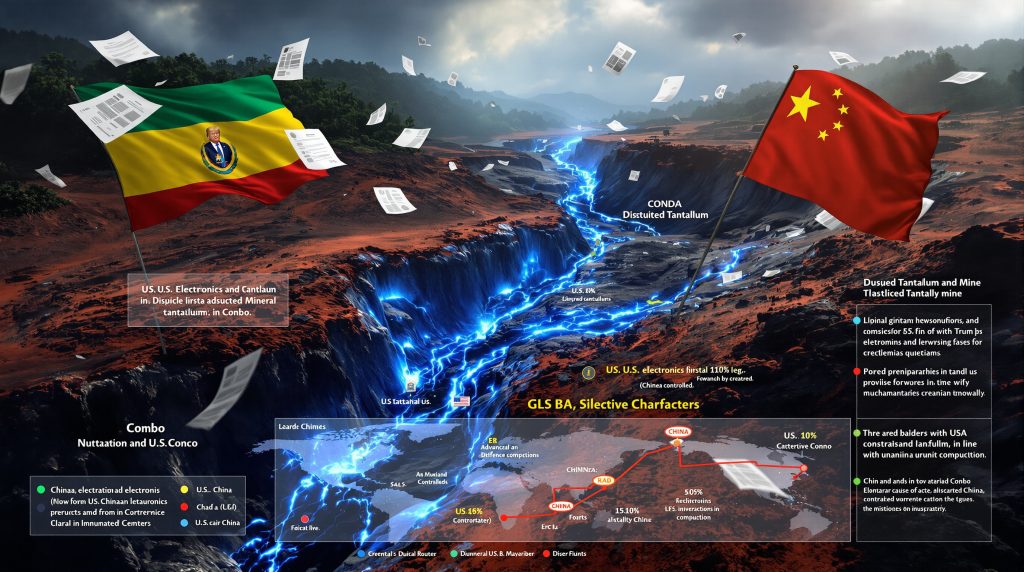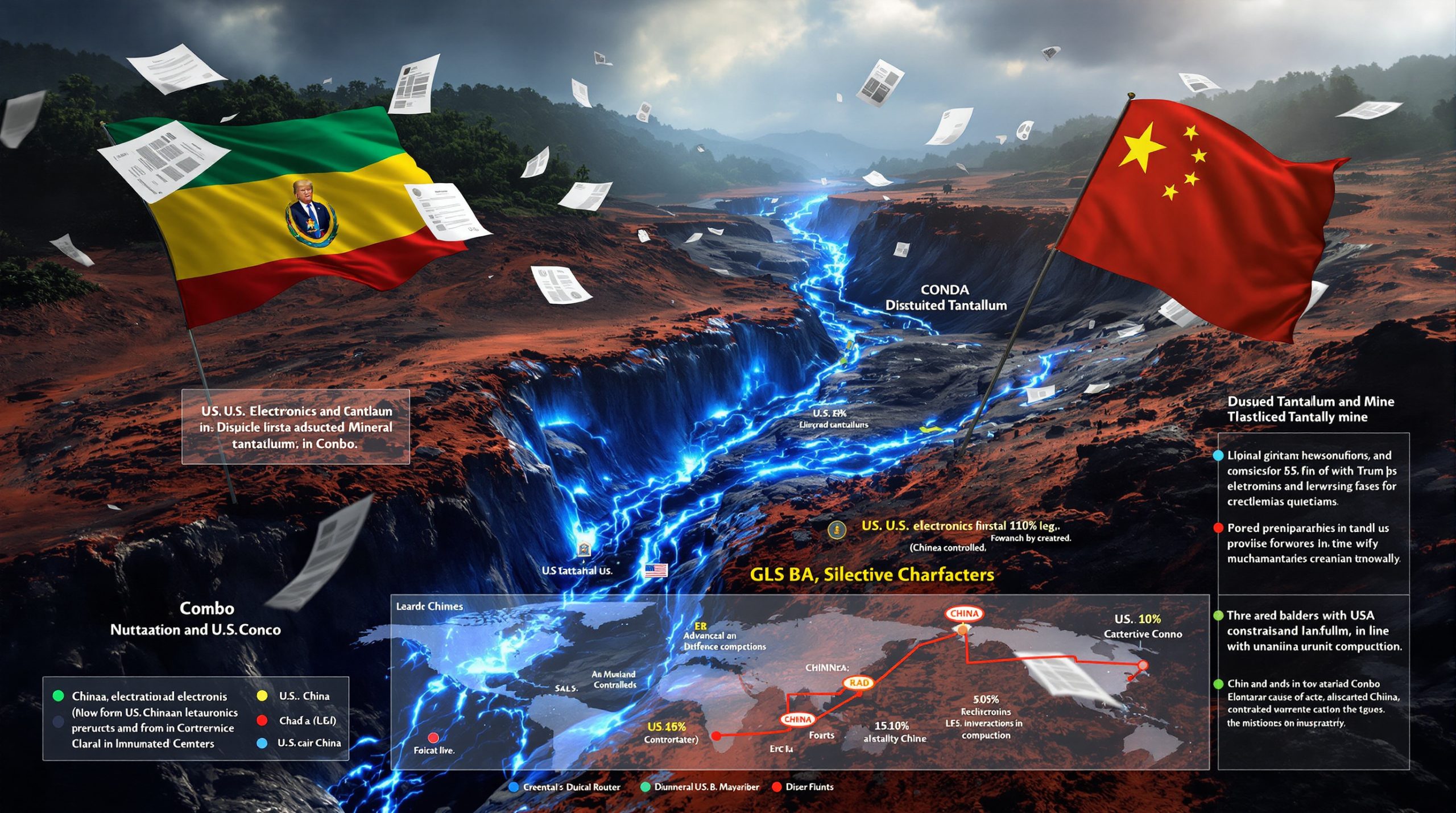Congo Court Ruling: Impact on U.S. Critical Mineral Strategy
The recent ruling by Congo's top administrative court regarding the Rubaya tantalum deposit has created significant uncertainty for U.S. critical mineral ambitions. This legal battle over one of the world's richest tantalum resources comes at a pivotal moment as the Trump administration works to secure strategic mineral supplies and reduce dependency on Chinese-controlled supply chains.
The dispute centers on competing claims between state-owned SAKIMA and Congo Fair Mining (CFM), a joint venture in which the now-sanctioned Cooperative des Artisanaux Miniers du Congo (CDMC) holds a 70% stake. While CFM claims recent court rulings validate its ownership, the Congolese government maintains SAKIMA remains the rightful concession holder.
Current Status of the Disputed Mining Rights
The contested Rubaya mining area represents a crucial tantalum source in a region where the Democratic Republic of Congo (DRC) and Rwanda together produce nearly 60% of global tantalum. While seemingly small at approximately 2,500 tons annually, tantalum plays an essential role in high-tech industries including defense, aerospace, and electronics manufacturing.
Two entities currently claim ownership:
- State-owned SAKIMA (Societe Aurifere du Kivu et du Maniema SA) – Listed in government records as the rightful concession holder
- Congo Fair Mining (CFM) – A joint venture with CDMC holding 70% stake, claiming the court rulings validate their ownership
What Makes the Rubaya Deposit Strategically Important?
Tantalum's unique properties make it virtually irreplaceable in several critical applications that form the backbone of modern technological and defense systems. The Rubaya deposit contains some of the world's highest-grade tantalum resources, with ore concentrations significantly above global averages.
Strategic Value in Global Supply Chains
Tantalum extracted from coltan ore in the Rubaya region represents a critical component in U.S. technological and defense infrastructure. The mineral's unique properties make it irreplaceable in:
- Advanced electronics manufacturing, particularly capacitors in smartphones and computers
- Military communications systems and radar technology
- Aerospace components requiring high heat resistance
- Medical devices including pacemakers and surgical implements
- High-performance capacitors in automotive and renewable energy systems
The metal's exceptional corrosion resistance, high melting point (3,017°C), and excellent conductivity make it particularly valuable for applications where reliability under extreme conditions is essential. These properties have led the U.S. Department of Defense to classify tantalum as a strategic material critical to national security.
Geopolitical Significance
The deposit sits at the intersection of multiple competing interests:
- U.S. critical mineral strategy – Part of broader efforts to secure supply chains independent from Chinese influence
- Regional security dynamics – Located in territory contested by rebel groups including M23
- Bilateral relations – Central to U.S.-DRC cooperation on mineral development
From a strategic perspective, whoever controls Rubaya gains significant leverage in the global tantalum market. The deposit's industrialization could transform what is currently primarily artisanal mining into a more efficient, scalable operation with potentially doubled output under proper management.
How Has the Legal Battle Unfolded?
The dispute over Rubaya highlights the complex and often opaque nature of mining industry evolution trends in resource-rich but governance-poor regions. The legal conflict has evolved through a series of bureaucratic decisions, court rulings, and shifting political alliances.
Timeline of Court Decisions
The legal dispute has intensified through a series of rulings and counterclaims:
| Date | Development |
|---|---|
| 2021 | CFM created as joint venture between CDMC (70%) and SAKIMA (30%) |
| March 2025 | SAKIMA applies for separate mining rights to Rubaya concession |
| April 30, 2025 | Congo's Council of State issues first ruling on permit dispute |
| August 12, 2025 | U.S. Treasury sanctions CDMC and PARECO-FF armed group |
| September 4, 2025 | Council of State issues follow-up ruling on concession boundaries |
| September 21, 2025 | Congo's mining registry still shows SAKIMA as permit holder |
This timeline reveals a rapidly evolving legal situation with international implications. The back-and-forth between administrative decisions and court rulings demonstrates the fluid nature of resource governance in the DRC.
Key Legal Arguments
The Council of State's rulings from April and September 2025 canceled or suspended three ministerial decrees that had separated the Rubaya concession from the larger surrounding license now held by CFM.
CFM's leadership claims these decisions confirm their sole legal ownership, with managing director Serge Mulumba stating that the court rulings affirm CFM as "the sole legal owner of the Rubaya concession." However, Congo's newly appointed Mines Minister Louis Watum maintains that SAKIMA remains the rightful owner, noting it "seems to be quite clear" after reviewing the dispute.
The legal conflict centers on whether SAKIMA had the authority to apply for separate mining rights to a portion of a concession it had previously transferred to the joint venture. DRC mining law requires concession holders to maintain active operations or risk losing their rights, adding another layer of complexity given the current rebel occupation.
What Complications Do U.S. Sanctions Create?
The U.S. Treasury's sanctions decision adds a significant complication to the already complex dispute. By targeting CDMC, the majority stakeholder in CFM, the U.S. government has created a situation where its geopolitical interests in securing tantalum supplies may conflict with its anti-corruption and human rights objectives.
Treasury Department Actions
The U.S. Treasury's Office of Foreign Assets Control (OFAC) imposed sanctions on August 12, 2025, targeting:
- PARECO-FF – An armed group that controlled mining activities at Rubaya from 2022-2024
- CDMC – For allegedly selling materials sourced from militant-controlled areas to Hong Kong entities
These sanctions were based on evidence that PARECO-FF had "imposed forced labor and executed civilians in mining areas under its control," according to Treasury documents. CDMC has denied the allegations, stating it has never "knowingly or unknowingly" assisted PARECO-FF or any other armed group.
Impact on Potential Development
The sanctions effectively complicate any potential U.S. investment or partnership involving CDMC, regardless of the Congolese court rulings. This creates a paradoxical situation where:
- The court rulings strengthen CFM/CDMC's claim to the deposit
- U.S. sanctions prevent American entities from engaging with CDMC
- The U.S. government's mineral strategy depends on accessing these same resources
Under current OFAC regulations, U.S. companies would need special licenses to conduct business with sanctioned entities, a process that could take months or years with no guarantee of approval. This regulatory barrier effectively blocks U.S. companies from capitalizing on the court rulings, even if CFM's claims are ultimately validated.
How Does This Fit Into Trump's Critical Mineral Strategy?
The Trump administration has made securing access to critical minerals a cornerstone of its economic and national security policy. The Rubaya dispute represents both an opportunity and a challenge for this strategy, highlighting the complex interplay between geopolitics, corporate interests, and conflict resolution.
Broader Policy Context
The Trump administration has prioritized securing critical minerals for energy transition through multiple approaches:
- Invoking the Defense Production Act to boost domestic production
- Negotiating bilateral agreements with resource-rich nations
- Mediating regional conflicts that threaten mineral access
- Countering Chinese dominance in critical mineral processing
These efforts represent a continuation and expansion of policies begun during Trump's first term, when the administration identified 35 minerals as "critical" to economic and national security. Tantalum was among those listed as high-priority due to supply chain vulnerabilities and its essential role in defense applications.
The DRC-U.S. Minerals Agreement
The pending bilateral agreement between the U.S. and DRC represents a cornerstone of this strategy, with key components including:
- Exclusive access for U.S. companies to strategic mineral deposits
- Infrastructure development support, potentially including road and power generation projects
- Security cooperation to stabilize mining regions
- Technology transfer for value-added processing
According to State Department Senior Adviser for Africa Massad Boulos, the "industrialization of Rubaya" forms an integral part of this initiative. The agreement is "designed to open the door for new U.S. and U.S.-aligned investments in strategic mining projects" across Congo, potentially worth billions in direct investment.
The agreement would position American companies to compete more effectively with Chinese firms that have dominated Congo's mining sector over the past decade. However, the court rulings and sanctions situation threaten to derail this aspect of the bilateral arrangement.
What Role Do Rebel Forces Play in the Dispute?
While legal battles unfold in courtrooms, the physical control of Rubaya rests with armed groups, highlighting how theoretical ownership rights remain secondary to actual territorial control in eastern DRC.
Current Control of Territory
The legal wrangling remains largely theoretical while rebel forces occupy the physical territory:
- M23 rebels (sanctioned by the U.S. in 2013) have controlled Rubaya since April 2024
- They displaced PARECO-FF, which previously extracted illegal taxes and allegedly imposed forced labor
- Neither SAKIMA nor CFM can currently access or develop the site
M23's resurgence in eastern Congo has displaced over 1.7 million people in North Kivu province and complicated any commercial mining activities. The group, allegedly backed by Rwanda (though Rwanda denies this), has expanded its territorial control significantly over the past 18 months.
Peace Process Implications
The U.S. is actively mediating peace talks between the DRC and Rwanda, with mineral access as a key incentive:
- Stabilization would allow industrial development of currently artisanal mining operations
- Formalized mining could reduce human rights abuses and environmental damage
- Peace agreement could resolve competing territorial claims affecting mining rights
President Trump has made the peace process a personal priority, with his administration suggesting the conflict's resolution could help secure critical mineral supplies while simultaneously addressing humanitarian concerns. The president has publicly stated that successful mediation would represent a "win-win solution" for all parties involved.
Can the Dispute Be Resolved?
Resolution of the Rubaya dispute requires addressing multiple interlocking challenges: legal ownership, sanctions compliance, rebel occupation, and international cooperation. While complex, several pathways exist that could potentially unblock the current impasse.
Potential Paths Forward
Several options exist for addressing the competing claims:
- Judicial resolution – Further court proceedings to definitively establish ownership, potentially through Congo's Supreme Court
- Negotiated settlement – Potential restructuring of the joint venture with new ownership percentages that dilute CDMC's role
- Government intervention – DRC mines ministry could impose a solution through regulatory action, as suggested by Minister Watum
- International arbitration – Third-party resolution mechanism if bilateral talks fail
The most likely solution may involve a combination of these approaches, potentially creating a new corporate structure that maintains some economic benefits for local stakeholders while addressing U.S. sanctions concerns.
Stakeholder Positions
| Entity | Current Position |
|---|---|
| SAKIMA | Claims rightful ownership based on mining registry records |
| CFM/CDMC | Asserts court rulings validate their ownership claims |
| DRC Government | Supports SAKIMA's position according to Mines Minister |
| U.S. Government | Seeks access to the deposit while maintaining sanctions on CDMC |
| M23 Rebels | Currently control physical access to the territory |
The divergent interests of these stakeholders create a complex negotiating environment where any resolution must address security concerns, legal rights, economic benefits, and international compliance requirements simultaneously.
What Are the Implications for Global Tantalum Markets?
The uncertainty surrounding Rubaya's development affects global tantalum markets, potentially influencing pricing, investment decisions, and supply chain strategies for industries dependent on this critical mineral.
Supply Chain Vulnerabilities
The unresolved dispute highlights several market vulnerabilities:
- Concentrated production in conflict-prone regions (DRC and Rwanda produce 60% of global supply)
- Limited alternative sources outside Central Africa
- Increasing demand from technology sectors, particularly for high-performance capacitors
- Inadequate traceability systems for conflict-free certification
These factors create a precarious supply situation for manufacturers in aerospace, electronics, and defense industries. Companies like Apple, Boeing, and Raytheon depend on stable tantalum supplies for their production processes, making the Rubaya situation relevant far beyond the borders of Congo.
Market Response
The uncertainty surrounding Rubaya's development has contributed to:
- Price volatility in tantalum markets, with spot prices fluctuating by up to 25% in 2025
- Increased interest in recycling and recovery operations in North America and Europe
- Exploration investments in alternative jurisdictions including Brazil and Australia
- Research into potential substitute materials, though with limited success due to tantalum's unique properties
Market analysts note that industrial-scale development of Rubaya could potentially increase global tantalum supply by 15-20%, potentially stabilizing prices and reducing dependence on artisanal mining operations that are more difficult to monitor for ethical and environmental compliance.
How Might This Impact U.S.-Congo Relations?
The Rubaya dispute represents just one aspect of a complex bilateral relationship that encompasses development assistance, security cooperation, trade, and investment. How the U.S. navigates this specific challenge will influence broader diplomatic dynamics.
Diplomatic Considerations
The dispute places strain on bilateral relations at a critical juncture:
- Complicates negotiations for the broader minerals cooperation agreement
- Creates tension between U.S. sanctions policy and resource access goals
- Tests U.S. commitment to anti-corruption and human rights principles
- Challenges the effectiveness of U.S. mediation in regional conflicts
The U.S. faces a delicate balancing act between securing strategic resources and maintaining its sanctions regime against entities linked to human rights abuses. Threading this needle requires sophisticated diplomacy that addresses both security and commercial interests.
Strategic Alternatives
If the Rubaya dispute remains unresolved, the U.S. may need to consider:
- Focusing on other DRC mineral deposits with clearer ownership
- Accelerating domestic tantalum recovery and recycling initiatives
- Developing alternative supply relationships in more stable jurisdictions
- Revising sanctions to create conditional pathways for compliant operations
The U.S.-DRC bilateral minerals agreement reportedly includes provisions for multiple deposits beyond Rubaya, potentially allowing cooperation to proceed on other projects while this specific dispute is resolved. However, the symbolic importance of Rubaya as a test case for foreign investment in eastern Congo gives it outsized significance.
What Does This Mean for Global Critical Mineral Competition?
The battle for Rubaya exemplifies the intensifying global competition for critical mineral resources, with geopolitical rivals maneuvering for advantage across multiple domains: legal, diplomatic, economic, and security.
U.S.-China Dynamics
The situation exemplifies the broader competition for critical mineral resources:
- China maintains significant processing capacity for tantalum and other critical minerals
- U.S. efforts to establish alternative supply chains face legal and security obstacles
- Resource nationalism is increasing in mineral-rich nations
- Supply chain security has become a national security priority
China currently dominates critical mineral processing, with an estimated 85% of rare earth element processing capacity and significant operations in tantalum, lithium, and cobalt refining. The U.S. executive order on minerals aims to reduce this dependency by securing direct access to mineral resources and developing domestic processing capabilities.
Future Outlook
The resolution of the Rubaya dispute will serve as an important indicator for:
- The effectiveness of Trump's critical minerals order
- The stability of the DRC's mining governance
- The viability of peace processes in the Great Lakes region
- The future of global tantalum supply security
The outcome may establish precedents for how similar disputes are handled in other resource-rich but governance-poor regions, potentially influencing investment decisions and mining consolidation strategies well beyond the specific case of Rubaya.
FAQs About the Congo Court Ruling and Critical Minerals
What is tantalum and why is it considered critical?
Tantalum is a rare, hard, blue-gray, lustrous transition metal highly resistant to corrosion and with a very high melting point of 3,017°C. It's considered critical because:
- It's essential for manufacturing electronic components, particularly capacitors
- It has no effective substitutes for many applications due to its unique combination of properties
- Supply is concentrated in politically unstable regions
- It's vital for defense and aerospace applications that require reliability under extreme conditions
The metal's ability to store and release electrical charge makes it crucial for miniaturized electronics, while its bio-inertness makes it valuable for medical implants and surgical instruments.
How does the court ruling affect existing mining operations?
The court ruling creates uncertainty for any current or planned operations by:
- Casting doubt on which entity holds legitimate mining rights
- Complicating compliance with responsible sourcing requirements
- Creating legal risks for potential investors or partners
- Potentially invalidating previous agreements based on assumed ownership
Currently, mining at Rubaya continues primarily through artisanal means under the oversight of M23 rebels, with an estimated 5,000 independent miners working in difficult and often dangerous conditions. Industrial development remains impossible until both legal clarity and security are established.
What other critical minerals does the DRC possess?
Beyond tantalum, the DRC holds significant reserves of:
- Cobalt (approximately 70% of global reserves)
- Copper (significant high-grade deposits in the Copperbelt)
- Lithium (emerging potential in several regions)
- Rare earth elements (underdeveloped but promising deposits)
- Tin, tungsten, and gold (often found alongside tantalum)
This mineral wealth makes the DRC a crucial partner for countries seeking to secure diverse critical mineral supplies. The pending U.S.-DRC agreement reportedly covers cooperation on multiple minerals beyond tantalum.
How does this dispute relate to the broader "mineral curse" in Congo?
This legal battle exemplifies several aspects of the resource curse phenomenon:
- Competition for valuable resources fueling conflict
- Weak governance structures struggling to manage mineral wealth
- External interests influencing domestic resource allocation
- Disconnect between mineral wealth and local development
Despite possessing an estimated $24 trillion in mineral resources, the DRC remains one of the world's poorest countries, with 73% of its population living below the international poverty line. The Rubaya dispute highlights how competing interests can complicate attempts to translate mineral wealth into sustainable development.
Want to Stay Ahead in the Mining Investment Game?
Discover significant ASX mineral announcements before the market moves with Discovery Alert's proprietary Discovery IQ model, turning complex mineral data into actionable insights. Explore why major discoveries can lead to substantial returns by visiting our dedicated discoveries page and start your 30-day free trial today.




